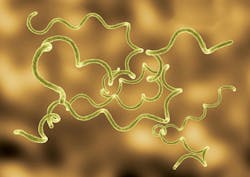Researchers at New Hampshire’s Dartmouth Hitchcock Medical Center have developed a new way to detect Borrelia burgdorferi, allowing for faster and more accurate diagnosis. Guohong (Grace) Huang, Ph.D., led the project and will present the work at the Association for Molecular Pathology (AMP) 2025 Annual Meeting & Expo, taking place Nov. 11–15 in Boston.
The project started with a case involving a 73-year-old woman who experienced progressively worsening skin hardening and inflammation as well as joint immobility over a four-year period. Doctors initially believed the patient had morphea, a condition that causes hard, thickened patches of skin. However, immunosuppressant medication used to treat morphea did not improve the patient’s symptoms.
In this patient’s case, antibody testing only showed evidence of prior Lyme infection, but she responded positively to the antibiotic doxycycline, a medication commonly used to treat Lyme disease.
Shaofeng Yan, M.D., Ph.D., a member of the patient’s care team, requested that Huang’s department develop a new molecular test to confirm the presence of Borrelia burgdorferi, leading to the larger study presented in Huang’s abstract.
The team, including Joel A. Lefferts, Ph.D., created three droplet digital PCR (ddPCR) tests—which are used to gather precise, highly sensitive measurements—to identify different types of Borrelia bacteria: one that detects all Borrelia species, one that targets those responsible for Lyme disease and one specific to Borrelia burgdorferi, the main cause of Lyme disease in the U.S. When tested on limited number of skin samples from patients with confirmed or suspected Lyme disease, the new assays showed excellent accuracy and could detect as few as five to ten bacterial cells.
Ultimately, the test for Borrelia burgdorferi developed by her team had an estimated sensitivity of 90.9% in formalin fixed, paraffin embedded samples, making it a potential new avenue for testing Lyme disease. Sensitivity is expected to increase when using fresh or frozen tissues, which typically yield DNA with higher quantity and quality.
“Using the ddPCR assay, we successfully detected B. burgdorferi DNA in this patient’s skin biopsy,” Huang said. “This finding was further confirmed by DNA sequencing, supporting the diagnosis of chronic Lyme disease.”
Huang noted that traditional serological tests cannot distinguish between active infection and past exposure.
“Antibody levels may remain elevated even after successful treatment. This is another clinical scenario where the ddPCR assay offers a clear advantage by detecting active bacterial presence rather than relying on indirect immune markers,” Huang said.
Although it took the patient more than four years to get a final diagnosis, the test developed by Huang and her team could save future patients from such extended waits. Early diagnosis is crucial in reducing the risk of long-term complications. With further development of the team’s test, prompt treatment will be possible for more patients.

